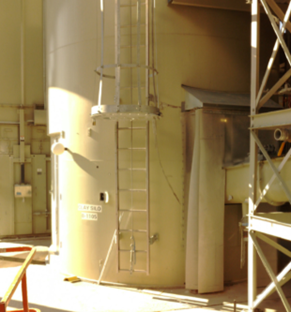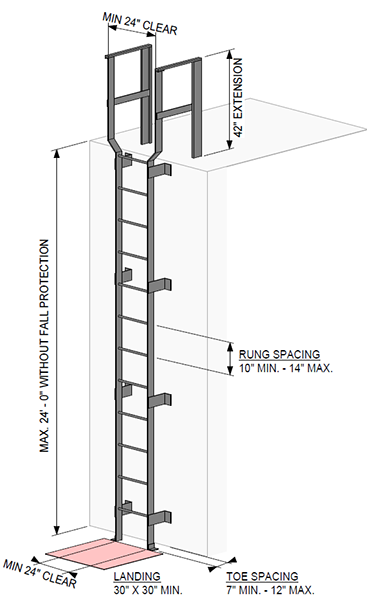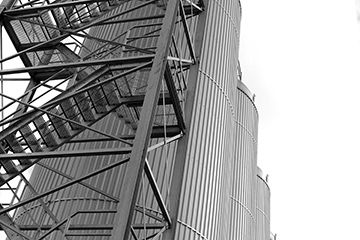In FY 2024, fall protection and ladders were in the top four most frequently cited Occupational Safety and Health Administration (OSHA) violations, totaling almost 10,000 violations. (ref) To counteract this, OSHA is tightening up ladder regulations. We are nearing the halfway point of the twenty-year implementation period that affects ladders and fall protection. Has your plant addressed these changes? If not, we recommend proactively implementing them sooner rather than later.
Back in January 2017, OSHA implemented new rules about Walking-Working Surfaces and Personal Fall Protection Systems to better protect industry workers. This rule affects fixed ladders, which are commonly found across industrial manufacturing sites and used by plant personnel – sometimes daily. Fixed ladders are often used to provide operators access to elevated platforms, instrumentation on equipment, tops of silos and tanks, and roof hatches.
Extensive research by OSHA has determined that cages alone are insufficient to prevent injuries, and in many cases the cage itself can cause significant injuries during a fall. OSHA has addressed these concerns with the latest standard (OSHA standard 1910.28) which took effect 11/19/2018. Ladders will now be required to have fall protection if their height is over 24-feet and the use of cages is being phased out. The new ladder fall protection systems are designed to catch the worker instantly, catching the worker within 3” to 9” of a fall, thus preventing injury.

Cages No Longer Recognized by OSHA As Fall Protection
Latest OSHA ladder requirements per 1910.28(b)(9):
- For caged, fixed ladders erected before November 19, 2018, employers have up to 20 years to install ladder safety or personal fall arrest systems.
- For new, fixed ladders erected on or after November 19, 2018, the employer must equip the ladder with a ladder safety or personal fall arrest system if ladder is over 24-feet in height.
- For ladder repairs and replacements, when an employer replaces any portion of a fixed ladder, the replacement must be equipped with a ladder safety or personal fall arrest system if ladder is over 24-feet in height.
- After November 18, 2036, all fixed ladders over 24-feet in height must be equipped with a ladder safety or personal fall arrest system.
A ladder safety system directly attaches to an existing or new fixed ladder and is designed to eliminate or reduce the possibility of a worker falling off the ladder. It usually consists of a carrier, safety sleeve, lanyard, connectors, and body harness. Cages and wells are not considered ladder safety systems.

OSHA Compliant Ladder Requirements
At Matrix Technologies, safety is our number one priority. Our team of engineers and architects are well versed in OSHA standards and building codes. We can help ensure your plant is optimizing operator and personnel safety and meeting all regulatory requirements. Many of our clients are eliminating ladders all together across their sites and proactively upgrading from ladders to permanent stairs.
How can we help?
- Site-wide inspection of existing ladders, identifying which meet OSHA compliance
- Recommendation/specification for suitable ladder fall protection system
- Design/details needed to replace or modify existing ladders to improve safety
- Means of egress studies
- Design of new fixed stairs to replace existing ladders
- Drawings prepared/stamped by Professional Engineer
- Contractor installation scope of work
- Construction cost estimating

Stair Tower Replaces 60’ Tall Vertical Ladders on Silos
Matrix Technologies is one of the largest independent process design, industrial automation, engineering, and manufacturing operations management companies in North America. To learn more about our facilities engineering and architecture capabilities, contact Lisa Lewis, Discipline Manager in Mechanical and Facilities.
References:
Occupational Safety and Health Administration (OSHA). Top 10 Most Frequently Cited Standards for Fiscal Year 2024 (Oct. 1, 2023 – Sept. 30, 2024). Retrieved from https://www.osha.gov/top10citedstandards.
© Matrix Technologies, Inc.